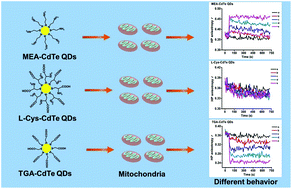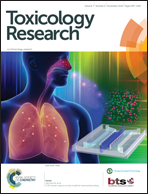Surface functional groups affect CdTe QDs behavior at mitochondrial level
Abstract
Quantum dots (QDs) are used in the bio-medical area because of their excellent optical properties. Their biomedical utilization has remained a serious biosecurity concern. Cytotoxicity experiments have shown that QD toxicity is connected to the properties of the QDs. In this paper, the toxicity of QDs was studied from the aspect of surface functional groups at the mitochondrial level. Three types of ligands, thioglycollic acid (TGA), mercaptoethylamine (MEA) and L-cysteine (L-Cys), which have similar structures but different functional groups were used to coat CdTe QDs. The effects of the three types of CdTe QDs on mitochondria were then observed. The experimental results showed the three types of CdTe QDs could impair mitochondrial respiration, destroy membrane potential and induce mitochondrial swelling. Interestingly, MEA-CdTe QDs showed similar effects on membrane potential and mitochondrial swelling as did L-Cys-CdTe QDs, while TGA-CdTe QDs showed stronger effects than that of the two other QDs. Moreover, the three types of CdTe QDs showed significantly different effects on mitochondrial membrane fluidity. MEA-CdTe QDs decreased mitochondrial membrane fluidity, L-Cys-CdTe QDs showed no obvious influence on mitochondrial membrane fluidity and TGA-CdTe QDs increased mitochondrial membrane fluidity. The interaction mechanism of CdTe QDs on mitochondrial permeability transition (MPT) pores as well as Cd2+ release by CdTe QDs were checked to determine the reason for their different effects on mitochondria. The results showed that the impact of the three types of CdTe QDs on mitochondria was not only related to the released metal ion, but also to their interaction with MPT pore proteins. This work emphasizes the importance of surface functional groups in the behavior of CdTe QDs at the sub-cellular level.

- This article is part of the themed collection: Toxicology Research Recent HOT articles


 Please wait while we load your content...
Please wait while we load your content...